When I did some study of Geology as a young man I was fascinated by fossils and very ancient rocks, but over the years I have come to see that soil is the most complex and interesting geological phenomenon on Earth. It is the point where Geology and Biology meet, as it is more than just an inert brown substance, but a complex ecosystem,almost a living reality in its own right.

Understanding your soil
by frankbeswick
To garden effectively you should have a good understanding of soil
The basic structure of soil
Soils vary around the world, but they tend to have a similar structure and come in layers of varying depths. They all rest on a layer of bedrock, which is sometimes solid and other times fragmented. Above the bedrock is subsoil, which is composed of rock fragments but has very ltttle organic matter, and above this the topsoil, the soil that we know, rich and complex, full of life and nourishment. Above this is sometimes a thin layer of decomposing leaves and debris that is becoming soil.
Scientists do not fully understand soil, as its chemistry is so complicated. In fact a soil is an immensely complex ecosystem that organic thinkers call the living soil. It is composed of a variety of rock fragments, organic matter and living creatures, known as the biota. The fragments are grouped into various types of texture: they can be sand, silt or clay, and depending upon the relative proprortions of each the soil is a sandy, silty or clay soil. The ideal soil is a loam, which contains a variety of each type. All soils also contain organic matter, a key element in which is humus, a complex black substance which is the product or decay or organic materials. It serves a vital role as a glue, binding soil together and holding water and nutrients, but it does decay and need replacing with organic materials. There can also be organic soils, which contain much peat, decaying vegetable matter, and these soils are humus rich. There are many of these in my native Lancashire in North West England. My own soil is interesting. The land has been an allotment for decades and so has been enriched with manure and compost, but when I wash leeks at home I find sand in the bottom of the basin, and this reminds me that the basic soil is sand, born of the new red sandstone that underlies our area.
A soil that contains a variety of different sized particles [clay, rock, sand etc] is said to have a good structure, because the irregularity allows for retention of water and nutrients in the spaces between particles. Gardeners often improve their structure by adding peat and compost.
Soils have different characteristics according to their dominant rock fragment. Sandy soils lose water fast and are dry, but they heat up quickly, which is why on the sandy heaths of Southern England we find a variety of small reptiles, that love the heat. Clay soils are slow to heat, retain water and are hard to work. But clay is a great source of nourishment, which is why organic composters like to add clay to their composts. Silt is somewhere between the two. Subsoils are mineral rich, but organic poor. The ideal plants for exploiting them are nettles and comfrey. their long roots penetrate deep and draw up minerals from the soil, which can be given to the garden by composting the plant.
Gardeners try to imporve their soil by adding organic matter, such as manure and compost, that make humus and provide nutrients. But they also sometimes add rockdust, that will augment the soil mineral content.
Soil
 | Nature's Footprint Glacial Rock Dust Soil amendment, 5-Pound Glacial Rock Dust is a soil amendment containing a broad range of trace minerals, many of which have been slowly lost through the ages on commercial farmland, by erosion, leachi... |
Types of soil
There is a staggering array of soil types, and growers really need to know the type of soil in which they are working. The most desirable type is brown earth soil, the farmer's dream. These are the soils that cover much of England. A thick, rich layer of brown, humus rich material covers a deep subsoil, and they are ideal for cultivation.
Other soils are not as useful. Rendzinas are shallow soils, generally above some kind of limestone. They are thought to be an early stage of soil formation, so they have a high proportion of tiny fragments, such as gravel, and so are not easy to work. We find them in the limestone uplands of parts of England. Cotswold Brash is a developed kind of rendzina. British readers familiar with the programme Countryfile will recognize this as the soil in Adam's Farm, whose presenter Adam Henson farms on this hard upland soil with a high clay and stone content derived from the underlying oolitic limestone. Adam grows oilseed rape, which likes the lime content, but he augments it with mushroom compost bought in from mushroom farms and plenty of fertiliser.
Podzols [US:spodosols] are found in many parts of the world. They are deceptive, consisting of a thick layer of coniferous forest leaf material over a heavily leached, sandy soil. Leaching is the washing away of soil minerals, and it occurs in areas of high precipitation or low water run off. Their low mineral content makes them nutritionally poor and so poor for farming. If I were gardening a podzol rather than the thick loam that I have I would use raised beds and import compost. A related type is prairie soil, found in the US, which develops where there is grassland rather than confiferous forest.
Gleys [Russian for grey] are poor soils found in areas where the soil is heavily compacted. Many Scottish highland soils are gleys, and they are found in parts of Canada. They look reddish brown at the surface, but below is a mottled grey-blue appearance. This occurs because stagnant soil water creates an environment in which soil bacteria use up available oxygen, which is then not replaced. They are very poor soils for growing. Stagnogleys are worse. They occur in unstratified soil such as glacial clay or the wind-borne clay known as loess, found in parts of Asia. Surface water gley occurs when there is sustained flooding and soil oxygen is used up, whereas ground water gley is found in areas of very high water table.
Lateritic soils are reddish brown tropical soils rich in nutrients, but they are rock hard and contain very little organic material, water and soil biota. They are distinctly hard to work.
Rain forest soils are quite poor, often being heavily leached, but they rely on swift, heavy recycling of nutrients, but when the trees are felled the nutrient cycle is broken and the soil deteriorates. This is happening in Brazil, but in that land there are areas of terra preta, a man-made soil that was developed by the Native Americans who farmed the jungle before the arrival of smallpox killed them off. This is a magnificently rich soil which occurs in patches in the jungle.
Compost
 | Exaco Trading ECO-2000 2.4 Gallon Kitchen Compost Waste Collector Making your own compost starts in the kitchen by collecting all your organic waste and adding it to your outdoor composter. As much as 30% of household waste can be composted an... |
 | OXO Good Grips Compost Bin OXO Compost Bin: Stop throwing food scraps in the garbage! Designed with the home cook in mind and attractive enough to leave on the countertop, the Compost Bin stores food scra... |
pH
Of critical importance is a soil's pH, which is assessed on a scale of 1-15. It is a measure of soil acidity. An acid soil is pH 1; an alkaline soil is pH 15. These extremes are incapable of cultivation. Most plants grow on a narrow range of soils ranging from 5.5 [quite acid] to 7, slightly alkaline. I remember doing a consultancy for a colleague whose home is up a hillside in North Wales, and when I was told that she had a pH of 4 I simply said "Use raised beds and import soil and compost."
Most plants are happiest at pH 6.5-7. Fruit likes this kind of pH, but members of the brassica family [cabbages etc] prefer a slightly higher pH of about 7. This is why they benefit if you lime the bed before you plant them, and the lime helps prevent club root, a fungal disease of brassicas which does best in slightly more acidic soil. Some plants prefer acidic soil. Blueberries belong to this group, and to grow them in containers in areas where the soil is not acid enough you need to add ericaceous compost, which is quite acid. Cranberries also fall into this category, and like blueberries are calciphobes [fearful of calcium.]
You can alter your soil's pH to an extent, but the trouble is that the scale is logarithmic. So pH 2 is ten times more alkaline than pH 1, and pH 3 ten times as alkaline as pH2. This means that if you want to add lime to move a soil from pH 7-8 you need ten times as much as is needed to move it from pH 6-7. Briging soil pH down by adding sulphur or organic matter is easier than bringing it up. There is a danger in having too high or too low a pH. Iin the complex chemistry of soil it is possible for higher or lower levels of PH to "lock up" certain essential nutrients, therefore causing deficiency diseases. The safest pH is between 6.5 and 7, for it is at this level that most plants thrive. There are some that thrive at other pH levels. When buying plants your garden centre will advise you if there are specific soil requirements. Carnivorous plants generally favour acidic soils, like the bog soils from which they come.
Soil enhancers
 | Earthworm Castings, 15 lb Earthworm castings (1-0-0) are one of nature's most abundant and effective fertilizers. A rich, odorless, all-natural organic product that is extremely cost-effective because yo... |
 | Charlie's Compost 10 lb Charlie's Compost (0.5-0.4-0.5) is a natural fertilizer and soil amendment made of chicken manure recycled with other locally-sourced carbon products. Three generations of benef... |
A tip
Here is a tip for those buying a new house: don't trust the soil in the garden. Builders are not always gardeners, and so when making the gardens they tip the subsoil dug up when they excavated the foundations. This subsoil, as you know is humus poor, so you get a ground that may be rich in nutrients [hopefully] but poor in organic matter and biota. Attention to the soil is vital. You will need to dig in compost and manure and possibly adjust the soil texture.
To adjust the texture you need to assess what you have. If the soil is sandy, add clay or loam. If the soil is clay, dig in sand and make sure that it is broken up. Most clays are slightly acidic, so adding lime flocculates them, which means breaks up the soil into manageable fragments. But in parts of Eastern England there are alkaline clays where this technique does not work. You can buy a pH testing kit at many stores. Good luck with your gardening.
Garden books
 | Organic Gardening Beginner's Manual *** #1 Amazon BESTSELLER in Vegetable Gardening ***Here's the ultimate "Take-You-By-The-Hand" beginner's manual for creating and managing your own organic garden. Even if you kn... |
You might also like
Sustainability through local tradition – Arts and CraftsA festival is a great outreach to the public. Very hands on, traditional and ...
Energy Conservation: Human Indifferences and the Consequencesenergy from fossil fuels may become difficult in the future. Finding alterna...



 TheThousand Year Gardenon 11/26/2025
TheThousand Year Gardenon 11/26/2025
 Women of the Gospelson 10/11/2025
Women of the Gospelson 10/11/2025
 Religious Gardenson 08/25/2025
Religious Gardenson 08/25/2025
 Doctor of the Church: John Henry Newmanon 08/03/2025
Doctor of the Church: John Henry Newmanon 08/03/2025



Comments
The compost bin contains anything,vegetable matter,, that will be able to be composted
Thank you for your comment below, in answer to my previous observation and question.
So the scraped or swamp-sourced compost ends in a compost bin with other compostables.
What is the material of the compost bin and what is the nature of moss compost's fellow compostables?
Thank you for your comment below, in answer to my previous observation and question.
So the scraped or swamp-sourced compost ends in a compost bin with other compostables.
What is the material of the compost bin and what is the nature of moss compost's fellow compostables?
Scrapingʻ it up or getting it from swampy ground, then placing it in a compost bin.
Thank you for your comments below Jul 7, 2022, in answer to my previous, same-day observation and question.
How do you get your moss-based compost?
There's moss on the upper- and the lower-north lawns, east- and west-ward of the north- to south-running retaining wall. I let it be as all part of a forest-floor look to the yard areas around chestnut, juniper, locust, maple, pine and willow trees.
Would you scrape such ground-covering moss for compost or would you work a moss base another way?
I prefer a moss based compost, as I think pine needles are slower to rot down.
Loam is good soil as it is a mix of sand, silt and clay. I think that the soil around Belfast is a good loam, as it is so good at growing crops. Much of the centre of Northern Ireland is of high quality soil.
The information about loamy soils made me think of what I just had read about Templeton rose as dog rose in loam or as Scotch rose in poor soils.
I meant to ask also about ericaceous compost.
Some west pond-specific online sources opt for 20 percent perlite and 10 percent each of compost, "garden soil" and sand for ericaceous compost. They prefer a base of such peat-moss substitutes as coconut coir, composted manure, leaf mold, pine needles or rice hulls.
Other west-pond sources suggest bracken, coffee grounds, conifer needles and deciduous leaves mixed with grit and sharp-particle sand.
Which, if either, would you select?
The search term rosa hibernica is rosa canina in loamy soil gave me Floricultural Cabinet, and Florist's Magazine: Articles Relating to the Floriculture of China 1833-1857, Volume 1 (The Private Collection of Charles W. Wason, Cleveland [Ohio], 1918) through Google Books.
The chapter Remarks on the Indigenous Roses of America, &c. By An Ardent Admirer has the observation that John Templeton received 50 guineas from the Botanical Society of Dublin for discovering a "new indigenous plant" that subsequently proved to be Rosa spinosissima in "poor soils" and Rosa canina in "loamy land" (page 153).
Online information from such sources as the gardenia site indicates that Rosa spinosissima is poor- and sandy-soil tolerant even as it prefers part-shaded or full-sun soils that are humusy, moist and well-drained.
Isn't that preference in line with the soil type into which "loamy land" fits? Mustn't there be other factors to understand, such as what you say above about light, pH, precipitation, slope, structure and texture?
I dwell in an area whose bedrock is New Red Sandstone overlain by a mixture of glacial and alluvial deposits. The mixture 0f sandy soil and clay goes down to some significant depth, so it isnot washed down from surface layers. I used to find sand grains in my kitchen sink when I washed home-grown leeks. Shop-bought leeks are well washed and show no sign of sand.